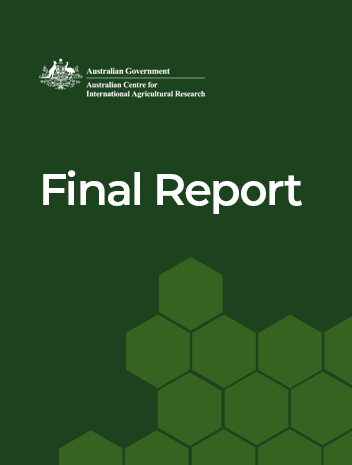- HomeHome
-
About ACIAR
- Our work
- Our people
-
Corporate information
- ACIAR Audit Committee
- Commission for International Agricultural Research
- Policy Advisory Council
- Agency reviews
- Executive remuneration disclosure
- Freedom of information (FOI)
- Gifts and benefits register
- Information publication scheme
- List of new agency files
- Contracts
- Legal services expenditure
- Privacy impact assessment register
- Commonwealth Child Safe Framework
- Benefits to Australia
- Careers
- 40 years of ACIAR
-
What we do
- Programs
- Cross-cutting areas
- Resources
- Where we work
-
Funding
- Research projects
- Fellowships
-
Scholarships
- John Allwright FellowshipScholarships to study in Australia for ACIAR partner country scientists to have Australian postgraduate qualifications
- ACIAR Pacific Agriculture Scholarships and Support and Climate Resilience Program
- Alumni Research Support Facility
- Publications
- News and Outreach
Project final report
Vulnerability in the Anthropocene: a prospective analysis of the need for social protection - Final Report
Date released
10 May 2023
ISBN
978-1-922983-07-7
Publication Code
FR2023-015
Overview
This report presents the results of the relation between human wellbeing (measured as income/consumption), natural capital (in particular, biodiversity, primary forest and soil) and climate in the rural areas of 7 Southeast Asian countries (Cambodia, Indonesia, Lao PDR, Myanmar, The Philippines, Timor-Leste and Vietnam).
The Covid-19 pandemic exposed how fragile were some of the progresses made towards reducing poverty and raised the need to better understand economic vulnerability and resilience to shocks.
The analysis combines data on income/consumption from recent representative Household Income and Expenditure Surveys with a rich set of other georeferenced data that measure natural capital and climate. Using Machine Learning techniques (in particular, regression forests and its interpretation through surrogate models) we classify rural households in 8 groups, characterised by distinct between-group living standards, and reflecting different environmental characteristics.
Conclusions
- The importance of poverty in rural Southeast Asia, with 41% of the households in our data being allocated to groups with average income below the poverty line.
- The considerable heterogeneity of the natural environment of poor households, aggregated in 5 distinct groups, in contrast with the remaining 59% (non-poor) households who were aggregated in, essentially, 2 large clusters.
- The importance of environmental risk in the first month of the rainy season (measured by the variance of temperature and variance of number of wet days): risk does create poverty in this data, suggesting a role to be played in the development of agricultural insurance (and, more generally, social safety nets). These groups also exhibit significant differences in terms of income variability which, together with differences in average income, lead to significant differences in vulnerability to poverty.
Our analysis shows that biodiversity richness predicts both lower income variability and lower expected income, suggesting that biodiversity conservation may come at the cost of increased vulnerability to poverty.



